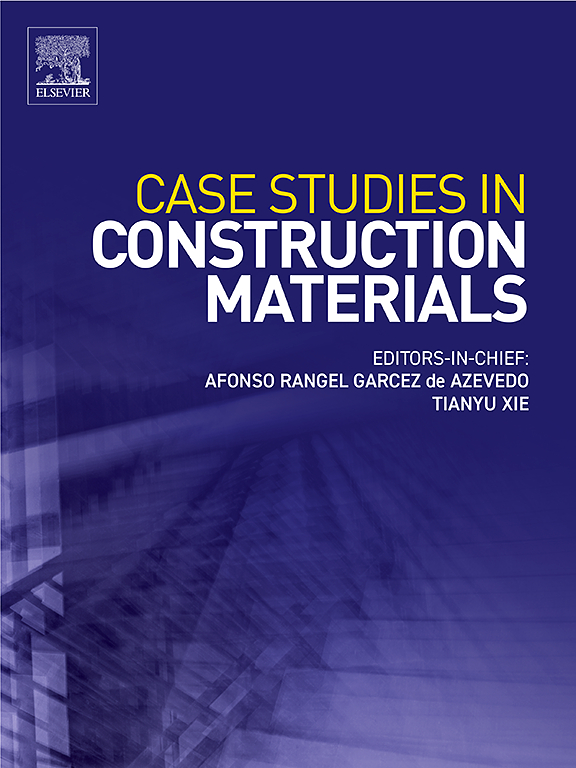Sagging behavior of precast NC beams with HPCs-filled wet joints incorporating pre-stressing technique
IF 6.6
2区 工程技术
Q1 CONSTRUCTION & BUILDING TECHNOLOGY
引用次数: 0
Abstract
Precast segmental beams constructed with normal concrete (NC) are widely adopted in modern infrastructure because of their advantages in decreasing on-site labor, shortening construction time, and observing high-quality control. Such segmental beams might require using construction joint with superior characteristics. However, the presence of intermediate constriction joints introduces potential weaknesses, particularly under sagging loading, which may result in bond degradation, cracking, or interface failure. This investigation presents a comprehensive experimental and numerical investigation into the flexural performance of precast NC beams incorporating high-performance concrete (HPC)-filled wet joints of varying developed lengths (ld), subjected to post-tensioning force. A total number of nine full-scale beams were experimented under flexural moments until failure. The considered parameters were: HPC type employed in the joint (ultra-high performance concrete (UHPC) and engineered cementitious composite (ECC)), the ld values (15, 20, and 25 times the bar diameter (D)), and the pressurising condition applied through of post-tensioning system. The results demonstrated that specific combinations of these parameters significantly enhanced cracking resistance, initial stiffness and energy absorption. Moreover, integrating a pre-stressing system with a UHPC-filled wet joint and a developed length of 25D led to an approximate 98 % increase in ultimate load. A nonlinear three-dimensional finite element model (FEM) was constructed and validated against the experimental outcomes, yielding high accuracy with discrepancies less than 4 %. Additionally, a novel predictive equation for the ultimate moment capacity of the studied beams was formulated, exhibiting a mean error margin of about 3 %.
结合预应力技术的hpc填充湿缝预制NC梁的下垂特性
普通混凝土预制节段梁具有减少现场人工、缩短施工时间、便于质量控制等优点,在现代基础设施中得到广泛应用。这种分段梁可能需要使用具有优越特性的施工接缝。然而,中间收缩接头的存在带来了潜在的弱点,特别是在下垂载荷下,这可能导致粘结退化、开裂或界面破坏。本研究对预制NC梁的抗弯性能进行了全面的实验和数值研究,其中包括高性能混凝土(HPC)填充不同开发长度(ld)的湿接缝,受到后张力的影响。共有9根全尺寸梁在弯矩作用下进行了试验,直至失效。考虑的参数是:接缝采用的HPC类型(超高性能混凝土(UHPC)和工程胶凝复合材料(ECC)), ld值(15、20和25倍杆径(D)),以及通过后张系统施加的加压条件。结果表明,这些参数的特定组合显著提高了抗裂性、初始刚度和能量吸收。此外,将预应力系统与uhpc填充湿节理相结合,开发长度为25D,可使极限荷载增加约98 %。建立了非线性三维有限元模型,并与实验结果进行了验证,得到了较高的精度,误差小于4 %。此外,还建立了一种新的预测梁的极限弯矩承载力的方程,其平均误差约为3 %。
本文章由计算机程序翻译,如有差异,请以英文原文为准。
求助全文
约1分钟内获得全文
求助全文
来源期刊

Case Studies in Construction Materials
Multiple-
CiteScore
7.60
自引率
19.40%
发文量
842
审稿时长
63 days
期刊介绍:
Case Studies in Construction Materials provides a forum for the rapid publication of short, structured Case Studies on construction materials. In addition, the journal also publishes related Short Communications, Full length research article and Comprehensive review papers (by invitation).
The journal will provide an essential compendium of case studies for practicing engineers, designers, researchers and other practitioners who are interested in all aspects construction materials. The journal will publish new and novel case studies, but will also provide a forum for the publication of high quality descriptions of classic construction material problems and solutions.
 求助内容:
求助内容: 应助结果提醒方式:
应助结果提醒方式:


